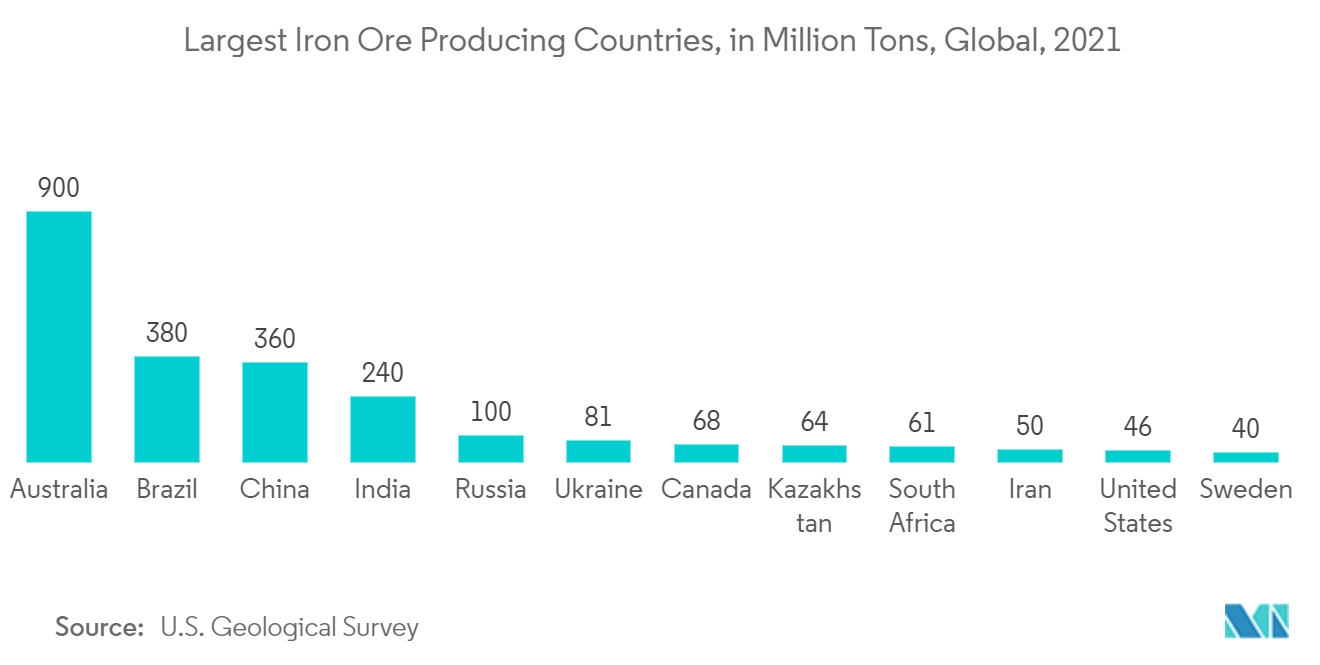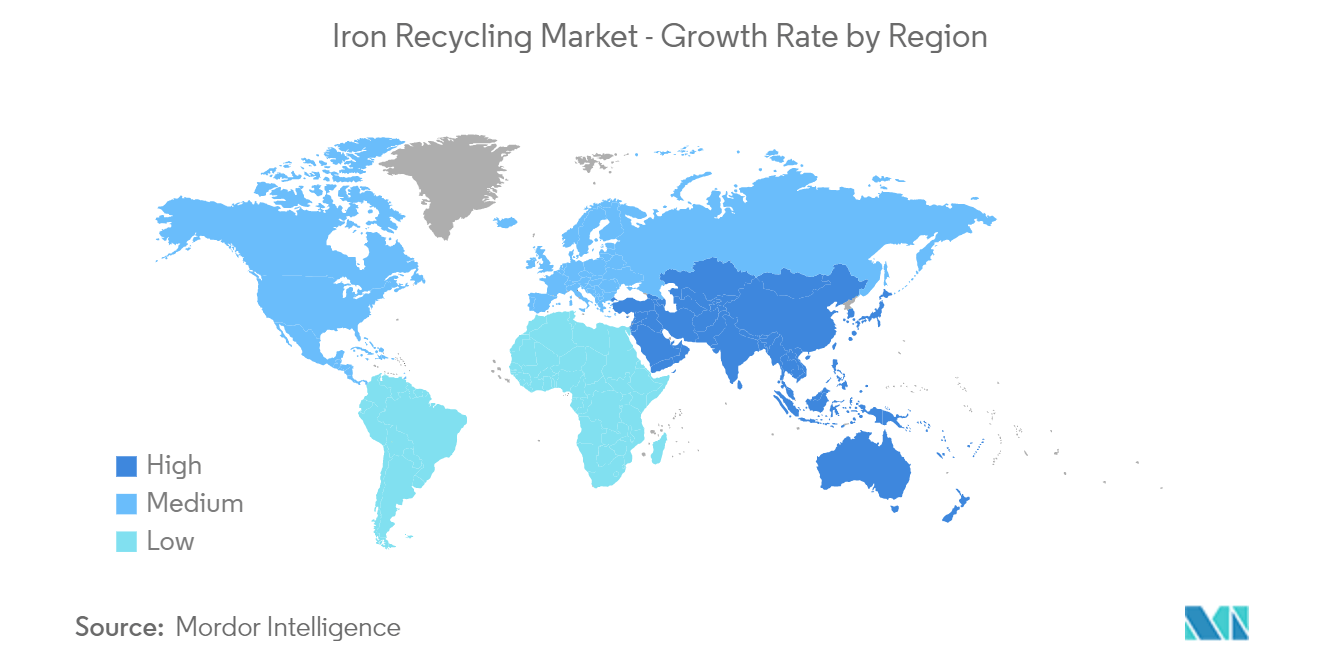Market Trends of Iron Recycling Industry
Building and Construction to Dominate the Market
- The construction segment dominated and is projected to be the fastest-growing segment during the forecast period. Due to the rapid growth of the construction industry and the rising demand for steel in renovation and remodeling projects, the construction segment is anticipated to experience the fastest revenue growth rate during the period.
- In 2021, 2.7 billion tons of metals were mined, of which roughly 93% was iron ore. It is used primarily (98%) to make steel, with the remaining 2% becoming magnets, auto parts, and catalysts.
- The scarcity of resources and the need to reduce environmental impacts are placing a greater emphasis on resource efficiency within the construction industry.
- According to the American Iron and Steel Institute (AISI), steel made from iron is the most recycled material on the planet. It can be recycled over and over again without any degradation of its properties.
- In 2021, the United States exported 19 million metric tons of iron and steel scrap, an increase of 2 million compared to the previous year. Over 46 million metric tons of iron and steel scraps were consumed in the U.S. market in 2021.
- Companies are investing in building production facilities to increase the recycling rate of iron metal to be used further in various industries. For instance, in 2022, Commercial Metals Company, or CMC, established a steel recycling facility in Martinsburg, United States. The company invested USD 450 million to construct this new facility, which will be completed in 2025.
- Steel is the world's most recycled construction material, and approximately 40% of all steel production is based on recycled scrap. According to the U.S. Geological Survey, in 2021, the leading overseas destinations for U.S. ferrous scrap were Turkey (3.47 million metric tons), Mexico (1.45 million metric tons), Vietnam (1.44 million metric tons), Taiwan (1.42 million metric tons), and Bangladesh (1.36 million metric tons).
- The increasing construction activities worldwide impact the positive growth of iron recycling. As more buildings are constructed, the demand for recycled iron and steel products will increase.
- All the above factors are responsible for increasing the industry's growth during the forecast period.

Asia-Pacific Region to Dominate the Market
- The Asia-Pacific region dominates the market for recycled iron products due to the large construction activities going on in various countries such as China, India, Japan, and others.
- Among all the other scrap metals, ferrous scrap, including iron and steel scrap, accounted for 17.9 million metric tons that flowed from the U.S. to overseas destinations in 2021.
- China has the largest building market in the world, making up 20% of all construction investment globally. The country alone is expected to spend nearly USD 13 trillion on buildings by 2030.
- According to the National Development and Reform Commission (NDRC), the Shanghai plan includes an investment of USD 38.7 billion in the next three years, whereas Guangzhou signed 16 new infrastructure projects with an investment of USD 8.09 billion.
- In 2022, India contributed about USD 640 billion to the construction industry due to government initiatives in infrastructure development and affordable housing, such as housing for all, smart city plans, and others. The growing construction activities in the country are driving the demand for iron in the country, which, in turn, may drive the iron and steel recycling market over the forecast period.
- According to the U.S. Geological Survey, Australia is the world's largest iron ore mining country, with 900 million tons of usable iron ore mined in 2021, followed by Brazil (380 million tons), China (360 million tons), and India (240 million tons). In 2022, mine production of usable iron ore in the country reached approximately 880 million metric tons.
- Large volumes of scrap are generated during the demolition of buildings as steel is used in their beams, reinforcement bars, and other structural parts. In September 2022, Re-Sustainability Limited received a contract from the Noida Authority in India to recycle 30 kilotons of waste generated from the demolition of the twin towers of Supertech, located in Noida, India.
- In 2021, roughly 1.6 billion metric tons of steel were produced, with China producing the majority at 1,032 million tons of steel. By contrast, China's steel scrap consumption reached 226.2 million metric tons, 3% less than the value in the previous year.
- Iron and steel are used efficiently in the automotive industry as well, as the components made of steel and iron make up around 65% of an average vehicle body. The average recycling rate for steel and iron in cars is about 90%.
- In the automotive industry, recycled iron and steel material is used in the manufacturing of automobile roofs and bodies. In 2021, China was the leader in the global auto market with sales of 26.27 million vehicles. The United States remained second at 15.4 million vehicles, followed by Japan at 4.44 million units.
- According to the India Brand Equity Foundation, the Indian car market is expected to reach USD 54.84 billion by 2027, while registering a CAGR of over 9%. The Indian automotive industry is targeting to increase exports of vehicles by five times by the year 2026. In 2022, total automobile exports from India stood at 5,617,246.
- Therefore, the above-mentioned factors will provide a growing market for iron recycling in the region during the forecast period.

